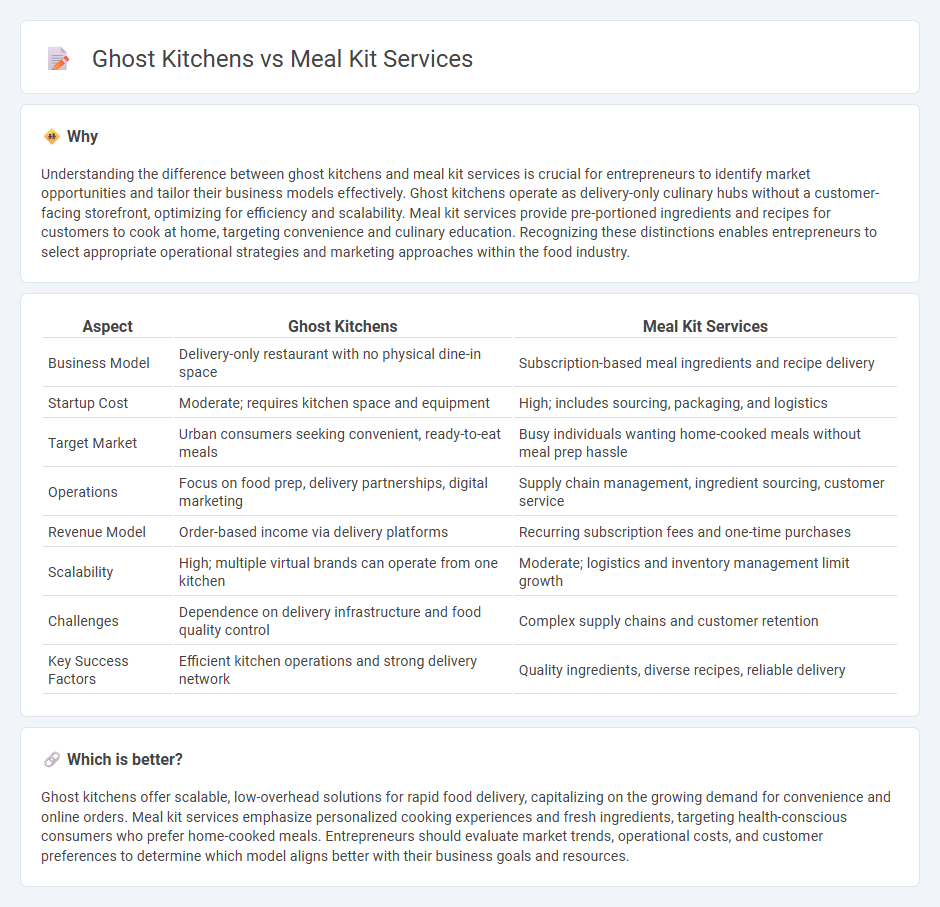
Ghost kitchens operate as delivery-only restaurants without physical dining spaces, leveraging lower overhead costs and rapid menu innovations. Meal kit services provide pre-portioned ingredients and recipes for consumers to cook at home, appealing to convenience and culinary experimentation. Explore the distinct biznes models and growth potential driving innovation in the food industry.
Why it is important
Understanding the difference between ghost kitchens and meal kit services is crucial for entrepreneurs to identify market opportunities and tailor their business models effectively. Ghost kitchens operate as delivery-only culinary hubs without a customer-facing storefront, optimizing for efficiency and scalability. Meal kit services provide pre-portioned ingredients and recipes for customers to cook at home, targeting convenience and culinary education. Recognizing these distinctions enables entrepreneurs to select appropriate operational strategies and marketing approaches within the food industry.
Comparison Table
| Aspect | Ghost Kitchens | Meal Kit Services |
|---|---|---|
| Business Model | Delivery-only restaurant with no physical dine-in space | Subscription-based meal ingredients and recipe delivery |
| Startup Cost | Moderate; requires kitchen space and equipment | High; includes sourcing, packaging, and logistics |
| Target Market | Urban consumers seeking convenient, ready-to-eat meals | Busy individuals wanting home-cooked meals without meal prep hassle |
| Operations | Focus on food prep, delivery partnerships, digital marketing | Supply chain management, ingredient sourcing, customer service |
| Revenue Model | Order-based income via delivery platforms | Recurring subscription fees and one-time purchases |
| Scalability | High; multiple virtual brands can operate from one kitchen | Moderate; logistics and inventory management limit growth |
| Challenges | Dependence on delivery infrastructure and food quality control | Complex supply chains and customer retention |
| Key Success Factors | Efficient kitchen operations and strong delivery network | Quality ingredients, diverse recipes, reliable delivery |
Which is better?
Ghost kitchens offer scalable, low-overhead solutions for rapid food delivery, capitalizing on the growing demand for convenience and online orders. Meal kit services emphasize personalized cooking experiences and fresh ingredients, targeting health-conscious consumers who prefer home-cooked meals. Entrepreneurs should evaluate market trends, operational costs, and customer preferences to determine which model aligns better with their business goals and resources.
Connection
Ghost kitchens and meal kit services both disrupt traditional food delivery and dining by leveraging streamlined, technology-driven operations focused on convenience and speed. Ghost kitchens optimize delivery-only food production without a physical storefront, while meal kit services provide pre-portioned ingredients and recipes for at-home cooking, both targeting busy consumers. Their shared reliance on data analytics, efficient supply chain management, and digital platforms highlights a convergence in the entrepreneurship landscape reshaping the food industry.
Key Terms
Business Model
Meal kit services operate on a direct-to-consumer subscription model, delivering pre-portioned ingredients and recipes to customers' homes, reducing food waste and simplifying meal preparation. Ghost kitchens, or virtual kitchens, focus on food delivery only, operating without a physical dine-in space and partnering with multiple food brands to optimize operational costs and expand market reach. Explore the detailed differences in scalability and profitability between these innovative food service business models to enhance your strategic decisions.
Supply Chain Logistics
Meal kit services rely on centralized warehouses sourcing fresh ingredients, optimizing inventory turnover with precise packaging to minimize waste and ensure timely home delivery. Ghost kitchens streamline supply chains by consolidating multiple restaurant brands under one roof, leveraging bulk purchasing and local distribution hubs to reduce costs and enhance order fulfillment speed. Explore how evolving supply chain innovations can transform food delivery efficiency and customer satisfaction.
Customer Acquisition
Meal kit services leverage personalized subscription models and targeted digital marketing strategies to attract busy professionals seeking convenience and fresh ingredients. Ghost kitchens optimize customer acquisition through partnerships with delivery platforms and dynamic pricing algorithms to capture on-demand food delivery market share efficiently. Explore detailed strategies behind customer acquisition to maximize growth in these emerging food service sectors.
Source and External Links
Home Chef: Meal Delivery Service - Home Chef offers weekly deliveries of fresh, perfectly-portioned ingredients with 20+ recipes each week, featuring plans for individuals and families, and flexible delivery days.
Sunbasket | Eat Well with Healthy Meal Delivery - Sunbasket specializes in healthy meal kits and heat-and-eat meals made from organic produce and clean ingredients, offering options for various diets such as gluten-free, vegetarian, and low-carb.
EveryPlate: Affordable Meal Kits Delivered - EveryPlate provides affordable meal kits starting at $5.99 per serving, with easy-to-cook recipes and up to 27 weekly options, focusing on simplicity and value.
 dowidth.com
dowidth.com